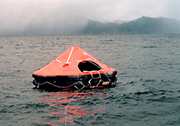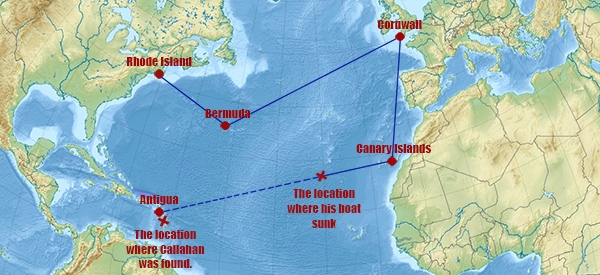Steven Callahan survived 76 days adrift with almost no water or food reserves. His true story is well documented and has been a reference point for many survival trainings, documentaries, movies and books.
How Callahan Survived 76 Days Adrift
After a hard breakup with his wife, Steven Callahan chose to experience life as he decided to use his own designed boat “Napoleon Solo” for a word tour.
Callahan departed Newport, in Rhode Island, in 1981 on his small boat (21.3-foot) and sailed to Bermuda then continued the voyage to England. He had left Cornwall, bound for Antigua as part of a single-handed sailing race. He dropped out of the race in Spain. Bad weather had sunk several boats in the fleet and damaged many others including Napoleon Solo. Callahan repaired the boat and continued voyaging down the coast of Spain and Portugal, out to Madeira and the Canaries. He departed the Canary Islands on January 29, 1982 heading for Antigua. After seven days his vessel was badly damaged by an unknown object during a night storm, and became swamped. Callahan suspected the damage occurred from a collision with a whale.

Unable to stay on his boat, he managed himself into a lifeboat he had bought a few days ago. He went back and forth and tried to retrieve some of his important properties from the boat, including an emergency kit. He had had no idea how important this decision proved to be later on.
“I started to pack my life-raft but realized that I’d have to dive down into the cabin if I wanted to get essential survival items – water, food, flares, a spear gun and sleeping bag. The boat was almost completely submerged, but I held my breath and went under again and again. … I was now adrift in the middle of the Atlantic, 800 miles west of the Canaries but heading in the opposite direction. All I had was a little food and enough water for a few days.”
In emergency situations like this, with very little time to think, most of the people would go for more water and food. But Callahan survived 76 days adrift only because he went back for the spear gun and some solar stills. He used the solar stills to produce drinking water and the spear gun for fishing. Callahan was constantly hungry and thirsty, but he managed to get just enough fishes and water to survive day by day.
His Daily Routine
Callahan survived 76 days adrift by learning to procure food and water. At first he didn’t knew how to use the solar stills or the spear gun. In fact he intentionally broke one of his solar stills just to learn how the mechanism works. He collected drinking water from the remaining two solar stills and other devices for collecting rainwater. Together they produced on average just over a pint of water per day.
With the help of the spear gun he managed to catch fishes. In one of his interviews he said that his meal mainly consisted in triggerfish and mahi-mahi, but he also speared some flying fish, barnacles, and birds. Having no means to make fire in a rubber boat he ate them raw.
He routinely exercised, made repairs, fished, improved systems, and built food and water stocks for emergencies. But like he said he had enough time to reflect on things like his divorce and how meaningless the breakup felt in those moments when his life was threatened.
Important Events
On day 14 he saw a ship, lit a flare but the ship just went right on by. Then in the next few days saw 9 other ships but none spotted him. Desperate and helpless he lost hope and almost gave up.
On day 40, he had an accident while fishing and part of the boat ripped. For the next 10 days he was at his lowest and constantly struggling to keep the raft afloat with a pump. He finally found a way to fix the raft and in his own words “it felt like the biggest victory of my life”.
On day 74 the solar stills packed up Callahan had only three cans of water left.

On the eve of the 75 day he spotted lights on the island of Marie Galante, south east of Guadeloupe. The next morning, after having survived 76 days adrift, he was spotted by some fishermen and rescued.
Callahan survived 76 days adrift but by the time he was found he had lost a third of his body weight, and it took him six weeks before he could walk properly again. He managed to float 1,800 nautical miles across the ocean which is almost the distance between New York and Los Angeles.
“I still don’t regret my 76 days alone in the raft. To this day I feel enlightened by what I went through because it changed me for the better. But would I want to be adrift in the ocean again? No way!”
How Callahan Experience Can Help You When SHTF
Callahan’s experience is a great lesson to everyone. First let’s see why he survived 76 days adrift, unlike other thousands of sailors who died in similar situation after only 4-6 days.
1. Before departing New Port, Callahan had bought a raft-boat and a survival kit including the items that helped him survive. Similar, in a SHTF situation you should perfectly choose what to pack in your bug out bag. And here is a list of things I would take.
2. One of the things that distinguished Callahan from other people in similar situations is that he thought his way out. Even if the boat was sinking, he dived down into the cabin and got his survival items. More so, even if the ships didn’t see him, he was able to rely on himself and move on. It’s normal to panic, but this does not mean one should stop thinking. Your way out of an SHTF situation is YOU!
3. Callahan survived 76 days adrift only because he managed to produce food and drinkable water. No matter how many supplies he would have had in his small raft, he wouldn’t have survived 76 days adrift. When SHTF, food reserved are a good option, but they just might not be the best. Especially when considering long terms scenarios. For example, a food crisis can last for up to 6 years. It’s almost impossible to properly store food for 6 years. And the investment: enormous! One of the best ways to produce food when SHTF is to build an Aquaponic System. A system that provides you with food and water – totally independent from the environment. It’s a lot to say on this subject and it’s not the focus of this article. So I think it’s better to see this video. Watch it and learn why you need your own sustainable food source and how you can produce food even when SHTF.














